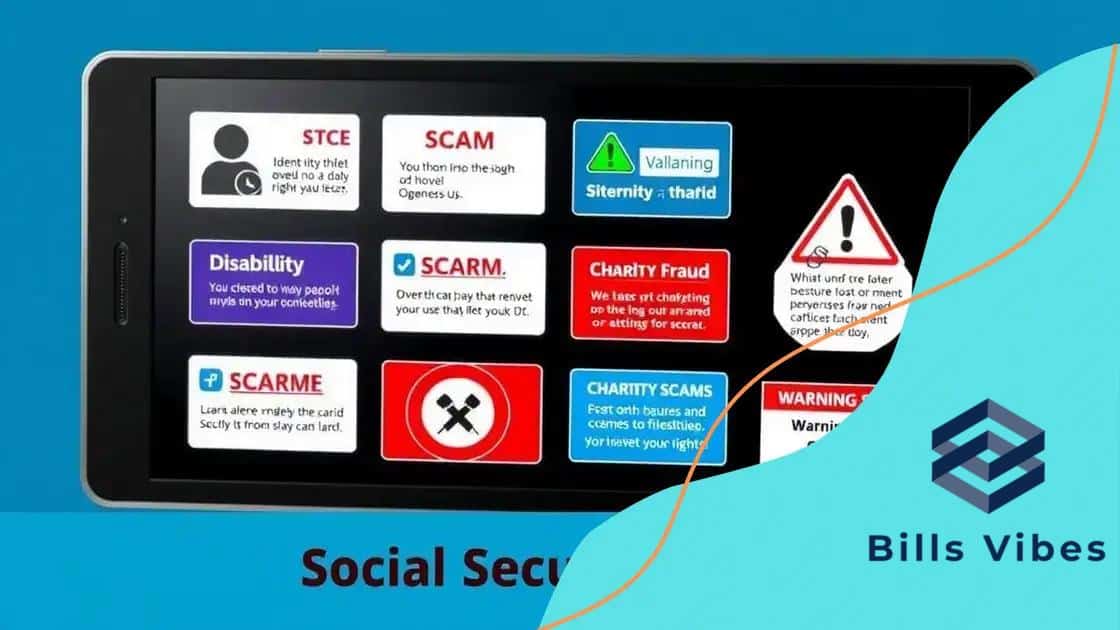Social Security fraud prevention ramped up: what you need to know

Social Security fraud prevention strategies include enhanced verification processes, public awareness campaigns, and advanced monitoring technologies to protect benefits and report suspicious activities quickly.
Social Security fraud prevention ramped up in recent times, and it’s essential for everyone to understand why these measures are necessary. Ever wondered how these changes impact your benefits? Let’s dive in and explore.
Understanding Social Security fraud
Understanding Social Security fraud is crucial for protecting your benefits and ensuring that the system remains sustainable. Fraud can take many forms, and it often targets the most vulnerable individuals. Early recognition and awareness can make a significant difference.
What is Social Security Fraud?
Social Security fraud refers to illegal actions that deceive the Social Security Administration to gain benefits or funds that are not deserved. This can include providing false information when applying for benefits or failing to report income.
Common Types of Social Security Fraud
- Identity theft: Someone uses your personal information to claim benefits.
- Misrepresentation: Providing false information about your disability status.
- Working while receiving benefits: Not reporting earned income while claiming disability benefits.
- Failed reporting: Not informing the SSA about changes in living conditions or work status.
Being aware of these fraudulent actions helps you understand how to report them. If you suspect someone is committing fraud, it’s essential to act promptly. The Social Security Administration has specific guidelines on how to report suspected fraud. This system exists to protect all citizens and ensure that benefits go to those who genuinely need them.
Moreover, the SSA has implemented advanced technology and increased staff training to recognize patterns of fraud. They are leveraging data analytics to spot anomalies quickly, making it harder for fraud to go unnoticed.
Protecting Yourself from Social Security Fraud
Taking preventive measures is vital. You should regularly monitor your Social Security statements and report any suspicious activities.
- Use strong passwords for online accounts.
- Safeguard your personal information.
- Be cautious with unsolicited calls or emails asking for sensitive details.
Knowledge is your best defense against Social Security fraud. Stay informed, know the common schemes, and take action if you notice something suspicious. By being proactive, you not only protect your benefits but also contribute to a system that works for everyone.
Current prevention strategies
Current prevention strategies against Social Security fraud are crucial for maintaining the integrity of the system. These measures help identify fraudulent activities and protect legitimate beneficiaries. Understanding what these strategies are can empower you to play a role in safeguarding your benefits.
Technology and Monitoring
The Social Security Administration employs advanced technology to monitor claims and payments. They utilize data analytics to detect unusual patterns that might indicate fraud. By analyzing large amounts of data, they can spot discrepancies and take action before fraud escalates.
Improved Verification Processes
Another significant strategy is enhancing verification processes. Applicants are required to provide more documentation to support their claims. This includes proof of identity and detailed records of income. These additional steps create barriers for potential fraudsters.
- Mandatory interviews for certain claims.
- Regular audits to verify beneficiary status.
- In-person visits to confirm eligibility in some cases.
Awareness campaigns are also key to prevention. The SSA conducts public outreach to educate citizens about the types of fraud and warning signs. When individuals know what to look for, they can report suspicious activities promptly, helping to protect the entire system.
Collaboration with Other Agencies
Collaboration is another essential component of current prevention strategies. The SSA partners with various agencies, including law enforcement, to share information and resources. This teamwork helps track down fraudsters and bring them to justice, reinforcing the message that fraud will not be tolerated.
Regular training for SSA employees is crucial as well. They learn about the latest fraud tactics and how to combat them effectively. This ongoing education helps staff stay vigilant and proactive in their roles.
In conclusion, the current prevention strategies against Social Security fraud are multifaceted. By using technology, improving verification processes, raising awareness, collaborating with other agencies, and training employees, the SSA actively works to protect beneficiaries.
Common fraud schemes to watch for

Being aware of common fraud schemes is essential for protecting your Social Security benefits. Fraudsters use various tactics to exploit weaknesses in the system and deceive innocent individuals. Understanding these schemes can help you stay alert and report any suspicious activities.
Identity Theft
Identity theft occurs when someone steals your personal information to access your Social Security benefits. This can involve using your Social Security number to apply for benefits. Once a fraudster obtains your identity, they can cause significant financial damage.
Disability Fraud
An often-seen scheme is disability fraud, where individuals misrepresent their health to receive disability benefits. This type of fraud can involve exaggerating medical conditions or failing to report a return to work.
- Claiming benefits without a qualifying disability.
- Continuing to work while receiving benefits.
- Hiding income or assets from the SSA.
Another common scheme involves fraudulent claims where individuals submit false information on their applications. They may provide incorrect details about income, family size, or other essential factors to qualify for benefits they do not actually deserve.
Charity Scams
Alongside these schemes, some fraudsters set up fake charities targeting vulnerable individuals. They may request donations under the guise of helping others but instead pocket the money. Be cautious of any unsolicited requests for donations related to Social Security or disability benefits.
Lastly, it’s crucial to be aware of telephone scams. Fraudsters might call, claiming to be from the SSA, asking for your personal information. Legitimate agencies will not ask for sensitive information over the phone.
Knowledge is power when it comes to spotting these scams. By staying informed about common fraud schemes, you can help protect yourself and others from falling victim.
Steps to report suspicious activity
Knowing the steps to report suspicious activity related to your Social Security benefits is vital for maintaining the integrity of the system. If you notice anything unusual or suspect fraud, taking action quickly can help protect your benefits and prevent further damage.
Identifying Suspicious Activity
The first step is to clearly identify what you find suspicious. This could include receiving unexpected payments, notices that you did not expect, or changes in your account that you did not initiate. Always trust your instincts; if something feels off, it probably is.
Gathering Information
Before you report an issue, gather all necessary information. Keep records of dates, times, and details of the suspicious activity. Documentation is essential for helping authorities understand the situation clearly.
How to Report
To report suspicious activity, you should contact the Social Security Administration directly. You can call their Fraud Hotline at 1-800-269-0271 or visit your local Social Security office. Make sure to provide all the information you gathered, as it will help them investigate the issue.
- Call the SSA Fraud Hotline.
- Visit your local Social Security office.
- Report online via the SSA website if applicable.
Besides reporting to the SSA, you may want to contact local law enforcement if your situation involves identity theft or other criminal activity. They can help evaluate the situation and provide guidance on the next steps.
Follow-Up
After reporting, follow up with the SSA if you do not receive confirmation of your report. Staying engaged helps ensure that your concern is addressed and that you remain informed about any potential outcomes.
Lastly, consider monitoring your credit report and Social Security statements regularly. This helps detect any further irregularities and ensures that your personal information is protected. Being proactive is your best defense against fraud.
How to safeguard your information
Knowing how to safeguard your information is critical in today’s world. With incidents of fraud on the rise, taking proactive measures to protect your personal data is essential. Simple steps can significantly reduce your risk of falling victim to scams.
Use Strong Passwords
One of the first steps in protecting your information is to create strong, unique passwords for your accounts. Avoid using easily guessed passwords like “123456” or your name. Instead, mix letters, numbers, and symbols to create stronger passwords.
Enable Two-Factor Authentication
Another effective way to enhance your security is to enable two-factor authentication (2FA) on your accounts. This adds an extra layer of protection by requiring not only your password but also a second form of verification, like a code sent to your phone.
- Secure important accounts, such as email and banking.
- Regularly update your passwords.
- Avoid using the same password across multiple sites.
Keep your personal information private. Be cautious about sharing details like your Social Security number or financial information unless absolutely necessary. Even seemingly harmless details can help fraudsters build a profile on you.
Monitor Your Accounts Regularly
Regularly checking your financial accounts can help you spot any unusual activity early on. Make it a habit to look for unauthorized transactions or changes to your account settings.
Additionally, utilize credit monitoring services to keep an eye on your credit report. These services can alert you to any suspicious activities, such as new accounts opened in your name, allowing you to act quickly.
Lastly, always be cautious of phishing attempts. Scammers may send emails or texts posing as legitimate organizations, trying to trick you into providing personal information. Always verify the source before clicking on links or providing any data.
FAQ – Frequently Asked Questions about Social Security Fraud Prevention
What should I do if I suspect Social Security fraud?
If you suspect Social Security fraud, you should report it to the Social Security Administration right away. You can call their Fraud Hotline or visit a local office.
How can I protect my personal information?
You can protect your personal information by using strong passwords, enabling two-factor authentication, and avoiding sharing sensitive details unnecessarily.
What are common signs of Social Security fraud?
Common signs include receiving unexpected notices or payments, and changes in your account that you did not make.
How often should I monitor my accounts?
It’s recommended to monitor your accounts regularly, at least once a month, to quickly catch any unauthorized transactions or changes.






